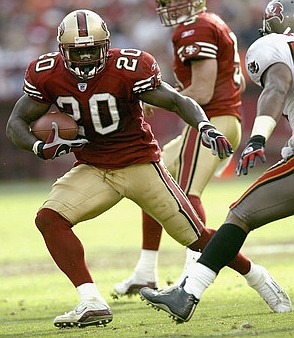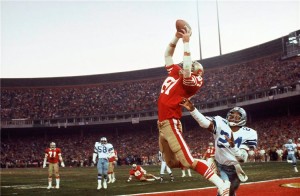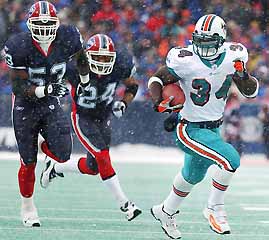First, a bit about the methodology. I’m going to use a very basic fantasy scoring system for the purposes of this post:
- 1 point for every 20 passing yards
- 1 point for every 10 rushing or receiving yards
- 6 points for every rushing or receiving TD
- 4 points for every passing TD
- -2 points for every passing INT
I’m also measuring players based on Value Based Drafting (VBD) points rather than raw points. In a nutshell, VBD measures true fantasy value by comparing a player to replacement level, defined here as the number of fantasy points scored by the least valuable starter in your league. For the purposes of this exercise, I’m basing VBD on a 12-team league with a starting lineup of one QB, two RBs, 2.5 WRs, and 1 TE. That means we’re comparing a player at a given position to the #12-ranked QB, the #24 RB, the #30 WR, or the #12 TE in each season. If a player’s VBD is below the replacement threshold at his position, he simply gets a VBD of zero for the year.
Here’s an example to show you how it works. O.J. Simpson’s 1975 is the greatest adjusted VBD season [1]Another note: for seasons of less than 16 scheduled games, I prorated VBD to 16 games. This applies to pre-1978 seasons where the schedule was 14 games, as well as the strike-shortened 1982 and 1987 … Continue reading by any player since the merger. He had 1,817 rushing yards & 16 rushing TDs, plus 426 receiving yards & 7 more TDs through the air, good for 362.3 fantasy points. The #24-ranked RB in 1975 was Green Bay’s John Brockington, who had 875 rushing yards, 4 rushing TDs, 15 receiving yards, and 0 receiving TDs for 113.0 fantasy points. Therefore, Simpson’s raw VBD was 362.3 – 113.0 = 246.7. He also did this in a 14-game season, so we multiply 246.7 * (16/14) to get 281.9 points of adjusted VBD.
Here are the 50 greatest VBD seasons since the merger: [2]Chase note: I charted Tomlinson’s chase of Simpson in December 2006. At the time, it looked like Tomlinson would end up breaking the record, but he fell off his ridiculous pace at the end of … Continue reading
That’s all background information. The way I want to measure “fluke” seasons is to look at the difference between a player’s best VBD season and his second-best; this should capture players whose best season truly stood out the most from all other seasons in his career. Some other requirements: the player had to produce at least 100 VBD points in his “fluke” year, he had to debut after the merger, and for active players, he has to have played at last 5 seasons through 2012.
Today, we’re going to start with those who just missed the cut, and the honorable mention category (a.k.a. numbers 21-30 in the fluke season countdown)… We’ll follow up with the top 20 on Saturday.
Barely Missed the Cut
Walter Payton, 1977 … LaDainian Tomlinson, 2006 … Drew Brees, 2011 … Nat Moore, 1977 … Chuck Foreman, 1975 … Jim Kelly, 1991 … Alfred Jenkins, 1981 … Shaun Alexander, 2005 … Terrell Davis, 1998 … Ahman Green, 2003. (Although it’s worth mentioning that Payton, Tomlinson, Brees, Foreman, Alexander, Davis, and Green made the top 50 list above, so we should probably cut them some slack).
Honorable Mention
30. Lorenzo White, 1992 – 124.9 VBD (1,226 rush yds, 641 rec yds, 8 TDs) … 2nd-Best Season: 1990 – 50.7 VBD (702 rush yds, 12 TDs)
Largely remembered by me for being a fumble-prone running back in the original Tecmo Super Bowl for the NES, White exploded for 1,867 yards from scrimmage at age 26 in the high-powered Run-and-Shoot attack of the 1992 Oilers. Sadly, it would be his last season of real fantasy note: never again did he finish among the top 24 running backs, as he amassed just 1,385 more rushing yards the rest of his career before retiring 3 seasons later.
29. Dwight Clark, 1982 – 120.5 VBD (913 rec yds, 5 TDs — 9-game season) … 2nd-Best Season: 1980 – 46.3 VBD (991 rec yds, 8 TDs)Clark had some good years, finishing as a top-18 fantasy WR for 6 straight seasons from 1980-1985, but none could ever top the performance he put up in the strike-shortened 1982 campaign. Pro-rated to 16 games, Clark put up the equivalent of 107 catches, 1,623 yards, and 9 TDs that year, numbers very much out of step with the rest of his career statistics.
28. Willie Parker, 2006 – 106.6 VBD (1,494 rush yds, 16 TDs) … 2nd-Best Season: 2005 – 28.9 VBD (1,202 rush yds, 5 TDs)
Parker was a top-5 fantasy RB in 2006, his second season as the Steelers’ starting RB, notching 1,716 yards from scrimmage and 16 total TDs. He was on his way to another decent campaign in 2007, but he broke his leg in the second-to-last game of the season and unfortunately was never the same, producing just 162 fantasy points in 2 more seasons before retiring.
27. Lynn Dickey, 1983 – 106.6 VBD (4,458 pass yds, 32 pass TDs) … 2nd-Best Season: 1984 – 26.4 VBD (3,195 pass yds, 25 pass TDs)
The first half of Dickey’s career was mostly that of a journeyman, with only 32 career starts through age thirty. At 31, he was given a chance to start for Green Bay, and he put up 3 fairly average seasons (-0.1 Relative ANY/A) before inexplicably having a monster [3]In every sense of the word: Dickey also had 29 interceptions. year — ranking 3rd among QBs in fantasy points — in 1983. After another good season in 1984, he declined sharply in 1985 and retired. And despite many great Brett Favre seasons, Dickey remained the single-season leader in passing yards in franchise history, until Aaron Rodgers threw for 4,643 yards in 2011.
26. Robert Brooks, 1995 – 110.0 VBD (1,497 rec yds, 13 TDs) … 2nd-Best Season: 1997 – 29.6 VBD (1,010 rec yds, 7 TDs)
Brooks enjoyed one of the numerous elite WR seasons that cropped up in 1995 — he was one of 6 players with 1,450+ yards and 9 with 100+ catches — seamlessly covering for the abrupt retirement of Sterling Sharpe by becoming Brett Favre’s #1 target. However, he was hurt midway through the 1996 season, and by the time he returned he’d lost a step and been supplanted by Antonio Freeman. After a 1,010-yard comeback season in 1997, he struggled through three injury-riddled campaigns and retired.
25. Ricky Williams, 2002 – 171.3 VBD (1,853 rush yds, 17 TDs) … 2nd-Best Season: 2003 – 90.3 VBD (1,372 yds, 10 TDs)While it seems like Williams stuck around forever, his best years were generally confined to the early stage of his career. He peaked with a monster 2002 (2,216 yards from scrimmage and 17 TDs) and was, on average, the 6th-best fantasy RB from 2001-03, but drug suspensions, a CFL stint, and a sojourn through Asia robbed him of prime seasons. With the exception of a 7th-ranked fantasy season in 2009, he was scarcely a fantasy factor at all during the latter half of his career.
24. Jamal Lewis, 2003 – 169.1 VBD (2,066 rush yds, 14 TDs) … 2nd-Best Season: 2007 – 85.4 VBD (1,304 rush yds, 11 TDs)
Lewis cranked out seven 1,000-yard seasons in his career, which generally made him a viable fantasy starter most years. However, he often just barely cleared the 1,000-yard threshold, he wasn’t a huge TD guy, and he added little in terms of receiving, making him a more mediocre fantasy option than you might think he was. The only real exception was 2003, when — fueled by 2nd-best rushing game in NFL history — Lewis became the 5th man to break 2,000 rushing yards, and also added 14 TDs.
23. Mark Brunell, 1996 – 120.5 VBD (4,367 pass yds, 19 pass TDs, 396 rush yds) … 2nd-Best Season: 2000 – 35.3 VBD (3,640 pass yds, 20 TDs)
Like Troy Aikman, Brunell was a very good real-life quarterback (his +0.4 Relative ANY/A ranks 40th among all passers who debuted since 1970) whose skills often didn’t translate to fantasy. Even during his prime, Brunell was typically a borderline fantasy starter: Tom Coughlin was more conservative back then, and Brunell only topped 3,200 yards four times and 20 TDs twice. His only fantasy season of any real note was 1996, when he cut loose with a career-high 557 pass attempts and grossed 4,367 yards, 727 more than he had in any other season.
22. Vinny Testaverde, 1996 – 142.2 VBD (4,177 pass yds, 33 pass TDs) … 2nd-Best Season: 1998 – 56.1 VBD (3,256 pass yds, 29 TDs)
Early in his career, Testaverde’s biggest concern was simply not sucking, much less being a viable fantasy quarterback; through 1995, he had a career -0.5 Relative ANY/A (which typically correlates to a 7-9 record per 16 games) and had never finished in the top twelve among quarterbacks in fantasy points (although you can read Jason Lisk’s thoughts on why Testaverde was better than you might think). In 1996, though, Testaverde was united with Michael Jackson & Derrick Alexander in Ted Marchibroda’s 3-WR offense and was permitted to throw the ball 549 times, producing 4,177 yards & 33 TDs. Vinny would go on to have a more efficient season at the helm of the more run-oriented Jets in 1998 (+2.4 RANY/A), but ’96 was his best fantasy season by far. [4]Glenn Foley began the 1998 season as the Jets starter, which meant Testaverde was limited to only 13 starts in ’98. That obviously hurt his fantasy value, but would not impact his RANY/A.
21. Garrison Hearst, 1998 – 137.1 VBD (1,570 rush yds, 535 rec yds, 9 TDs) … 2nd-Best Season: 2001 – 50.3 VBD (1,206 rush yds, 5 TDs)
Hearst spent the first four years of his career kicking around between the Cardinals & Bengals, producing a nondescript 2,350 rushing yards and just five total touchdowns from 1993-96. Even in 1997, his first year as a 49er, the former #3 overall pick wasn’t anything special, gaining 1,019 yards on the ground while being spelled by Terry Kirby. But in 1998, Hearst opened the season by beating the Jets with a 96-yard walk-off TD run in overtime and didn’t let up, eventually amassing 2,105 yards from scrimmage. Unfortunately, Hearst would miss all of the following 2 seasons with an ankle injury sustained during the ’98 playoffs, and while he came back with a couple of decent years in 2001-02, he was finished as a starting running back by 2003.
Stay tuned for the top 20 fluke fantasy seasons tomorrow!
References
| ↑1 | Another note: for seasons of less than 16 scheduled games, I prorated VBD to 16 games. This applies to pre-1978 seasons where the schedule was 14 games, as well as the strike-shortened 1982 and 1987 seasons. |
|---|---|
| ↑2 | Chase note: I charted Tomlinson’s chase of Simpson in December 2006. At the time, it looked like Tomlinson would end up breaking the record, but he fell off his ridiculous pace at the end of the season. |
| ↑3 | In every sense of the word: Dickey also had 29 interceptions. |
| ↑4 | Glenn Foley began the 1998 season as the Jets starter, which meant Testaverde was limited to only 13 starts in ’98. That obviously hurt his fantasy value, but would not impact his RANY/A. |



